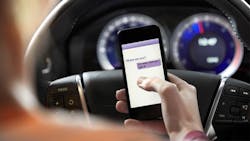The potential for driver distraction grows as we add more electronics to vehicles. Cell phones, Wi-Fi, televisions, navigation, music, and social media all are major attention grabbers. Driving is difficult enough, and these extras can lead to disaster. Manufacturers are aware of these dangers and are working to minimize them in the infotainment products now showing up in most new cars and trucks.
The National Highway Traffic Safety Administration (NHTSA) recently posted its distraction guidelines.1 These voluntary guidelines suggest how car OEMs should install electronic devices to mitigate driver distraction. The NHTSA also recommends disabling applications like texting, browsing, video phoning, e-mails, and social media.
Cell phones are a major distraction. Some states have laws forbidding cell calls, but most do not. Hands-free Bluetooth links help, but they aren’t completely safe. Texting is a death wish, and recent studies show that the number one cause of teen driver deaths is texting, not alcohol or speed. Some states already have laws against driving and texting. Voice-to-text and text-to-voice texting isn’t any improvement.
Video is a huge distraction too. Backseat TV and video is now available in some vehicles and acceptable. But proposed dashboard video, even for the front-seat passenger, will be a crash producer. Dashboard TV is a reality in Japan and South Korea now, but don’t look for it in U.S. vehicles any time soon.
Navigation systems are another distraction. Following your GPS system constantly takes your eyes off the road. Voice turn-by-turn navigation is one good solution, but it isn’t completely safe either.
People are determined to multitask while driving. The moment they get into a car, they get on the phone, turn on the music, or find some other distraction. It’s going to be interesting to see how the new infotainment systems and other telematics affect driving habits, especially as Google Glass hits the market. Looking ahead, though, West Virginia state legislator Gary G. Howell has introduced H.B. 3057, which would ban the use of head-mounted displays while driving in the Mountain State.2
References
“U.S. DOT Releases Guidelines to Minimize In-Vehicle Distractions,” http://www.nhtsa.gov/About+NHTSA/Press+Releases/U.S.+DOT+Releases+Guidelines+to+Minimize+In-Vehicle+Distractions
H.B. 3057, www.legis.state.wv.us/Bill_Status/bills_text.cfm?billdoc=hb3057%20intr.htm&yr=2013&sesstype=RS&i=3057
About the Author

Lou Frenzel
Technical Contributing Editor
Lou Frenzel is a Contributing Technology Editor for Electronic Design Magazine where he writes articles and the blog Communique and other online material on the wireless, networking, and communications sectors. Lou interviews executives and engineers, attends conferences, and researches multiple areas. Lou has been writing in some capacity for ED since 2000.
Lou has 25+ years experience in the electronics industry as an engineer and manager. He has held VP level positions with Heathkit, McGraw Hill, and has 9 years of college teaching experience. Lou holds a bachelor’s degree from the University of Houston and a master’s degree from the University of Maryland. He is author of 28 books on computer and electronic subjects and lives in Bulverde, TX with his wife Joan. His website is www.loufrenzel.com.
